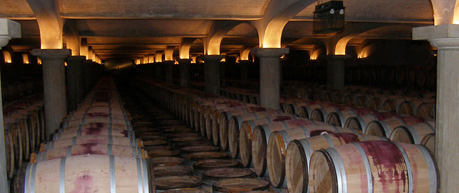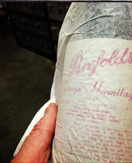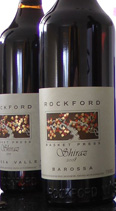The purpose of these reviews is not an attempt to measure the hedonist nature of
a newly released wine by describing its features through tasting notes and a
score but to review the past history of the wine through real sales data
available from the secondary market and attempt to determine the merits of this
current
release from a value point of view.

The secondary wine market in perspective
When valuing a wine it is important to understand why
there are huge price
variations (positive and negative) between the primary market for wine and the secondary market and to also
realise that wine cannot be treated as a vehicle for investment as you would
treat a stock in a company on the share market.
Primary Wine Market
Nearly all wine
that is purchased 'new' is consumed within two weeks and only a
tiny percentage of wine makes its way into storage for later consumption or
eventually for sale on the wine auction market.
Advocates for this market are wineries and sales are driven by mainstream advertising, primary wine reviewers and
often big PR budgets.
Secondary Wine Auction Market
The secondary market for fine wine is driven by a well informed and highly
engaged community of consumers who value wine based on personal experience and
shared common knowledge. The value of the wine changes over time as more
information is shared within the community. The wine contains no intrinsic value
itself except the common market value attributed to it by the community and
ratified by any auctions or sales over time. The only commercial advocates for
the wines in this market are auction houses.
Share
Market
Unlike wine prices, share prices are driven by rational, unbiased assumptions
and, at any present time, all estimated future returns are bundled into the
current share price which may change as new information is revealed, as such, it
is ridiculous to consider that a bottle of wine can be indexed or tracked like
shares in a company, a typical share generates value for its owner whereas a
bottle of wine cannot generate any real value until it has been opened, and in
the process destroyed, hence wine prices are pure speculation and not a
reflection of intrinsic value.
Auctioneer Wine Reviews
Penfolds Grange Shiraz 2008
Review Date: 2nd May 2013
Investment Value Rating:

 Release
Date: 2nd May 2013
Release
Date: 2nd May 2013
Australian Release Prices(s)
Recommended Retail Price by Penfolds: $785
Discounted(s) Retail Prices: $669 and going down.
I expect it to be discounted down to as much as $620 and to be trading
within a year at auction in a range between $500 and $600 (availability in
Australia will still be low). However, if the large quantities of Grange that
were sent overseas find their way back to Australia as the 1998 Grange did then
the value will drop down to around $450 if not lower.
Note: International prices are not quoted as
they are always listed without duty and taxes ( add 40% to their value) .
Previous Vintage Auction Prices:
Average price paid at auction between April 2012 to March 2013
- 2007 Penfolds Grange $400
- 2006 Penfolds Grange $520
- 2005 Penfolds Grange $400
- 2004 Penfolds Grange $420
- 2003 Penfolds Grange $375
- 2002 Penfolds Grange $385
- 2001 Penfolds Grange $360
- 2000 Penfolds Grange $390
- 1999 Penfolds Grange $385
- 1998 Penfolds Grange $515 –
Summary of the 2008 release
There is absolutely no doubt that Penfolds Grange is a world class wine on
par with the best of the French premium wines and the 2008 vintage is a superb
example! However, the secondary market is skewed towards domestic trading only
and is decades away from any investor achieving even the initial outlay let
alone the extra costs involved with storage, transport and auction commissions.
If China or the USA were to take up Grange consumption (as opposed to
speculative buying that does not contribute towards a sustainable long term
pricing structure) in a similar manner that they consume Bordeaux and Burgundy,
then there is a good possibility that international buyers of Grange would see a
substantial price rise. However, that trading would be confined to offshore
auctions while the domestic market continues to struggle with prices bloated by Australian
government duties and taxes.
So if you must have each new release for your collection then expect to pay
high prices for some time over the next 6 months at least. But if you are able
to wait patiently it will pop up soon enough as a discard from an over anxious
speculator selling it to buy their next under-researched venture.
Last reviewed by Mark Wickman on the
Rockford Basket Press Shiraz 2010
Review Date: 28th April 2013

Investment Value Rating:

Release Date(s):
a. September 2012 (Exclusive to mailing list only)
b. 1st March 2013 (Public release, 3 bottle limit from cellar door)
Release Price(s):
1. Cellar Door = $57 (3 per household limit)
2. South Australian retailers = $75
(Only have 6 to 12 bottles allocated each)
3. Other Australian states = $100+
Previous Vintages Auction Prices (in the last 12 months)
Exceptional Vintages
1998 Rockford Basket Press $150 to $200
2002 Rockford Basket Press $108 to $162
2004 Rockford Basket Press $97
to $127
Average Vintages
2003 Rockford Basket Press $86 to $102
2007 Rockford Basket Press $75 to $90
Summary
The 2010 vintage of the Rockford Basket Press is said, by most impartial
wine critics, to be one of the best vintages in some time. If that is the case
then it is possible that the secondary market price may reach as high as $110
within a year or two (it is already trading at $100+ when placed at auction),
with the potential to reach values achieved by other exceptional basket press
vintages.
This wine is certainly a buy proposition and a short stint in the cellar of a
year should yield some pleasant results. The trick is to grab it at cellar door
price or from South Australian wine retailers (still available as of 27th April
2013). However, because of the limits imposed, there are few actual gains to be
made as a real investment and opening the bottle and sharing it with friends
will yield the best results!
Last reviewed by Mark Wickman on the
Values have been aggregated from national secondary market data.
Notes on pricing and valuations
Low Range
Typically, price clusters form over time at market value. The low value is then
calculated from the average accumulated hammer price at auction from multiple
Australian wine auction houses over a 6 month period. All prices are for bottles
with no damage or ullage. Well stored bottles with a documented purchase and
storage history will always attract the best prices.
High Range
High prices are typically outliers or record high values achieved over
a long period of time and,typically, includes only a very low sample of bottles
sold, never the average and most often only a single bottle.
A
note on auction reserves
All auction houses generally set a reserve price 10% less
than the low price range. This allows for fluctuations of the market price going
down as well as up.
Author: Mark Wickman
wineauction@wickman.net.au
Google+
Copyright ©2013 Mark Wickman, All Rights Reserved.